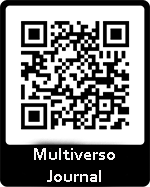Rules for authors
- Multiverso Journal will only consider unpublished works for publication and those that have not been simultaneously proposed to other journals. The reception of works will be carried out throughout the year.
- Papers must conform to the thematic orientation of the journal and its standards. Manuscripts will have a maximum length of twenty (20) pages, written in Times New Roman font number twelve (12), double spaced and with the following margins: left three (3) centimeters; right, upper and lower two (2) centimeters. The numbering must be consecutive and in Arabic numerals. It must be written impersonally.
- The title must be explanatory and contain the essence of the work, if possible, it must not exceed ten (10) words.
- The summary of the work must include objectives, methodology, results and conclusions, its maximum length is two hundred (200) words written with one space and must contain four (4) keywords, which will reflect the content of the article and will be present. in the abstract. The aforementioned keywords are necessary for their inclusion in international indices. It must be indicated in the title with an asterisk (*), at the bottom of the page of the summary, if the work is part of an investigation or has been used for other purposes, such as presentations, progress of projects or research programs, among others. The title of the work, the abstract and the keywords must be presented in languages: Spanish and English (abstract).
- Write full names and surnames of the author(s), without professional titles. Indicate, at the bottom of the page of the summary of the work, the institutional affiliation indicating the organism, the institution, the center, the institute or the dependency, as well as their addresses, ORCID ID and emails.
- The body of the work must have the following order: introduction, development and conclusions. The development should be divided into sections, identified by subheadings. The comments at the bottom of the page will be made when strictly necessary for additional explanations, numbered consecutively, and written with one (1) space.
- Bibliographic citations included in the text must be made by the author's last name and year of the work, for example: (Contreras, 2005). When the quote is textual, it is placed between quotation marks, and the author's last name, year of the work and page number must appear, for example: (Villasmil, 2021: 56); In the case of three authors, the surnames of the first author that appears in the text to be cited are placed and the expression et al is added, for example: (Contreras et al., 2005: 24). If the citation is made up of several continuous pages, they must be separated by a hyphen, for example: (Contreras, 2005: 54-55), when the citation is made up of isolated, non-continuous pages, they must be separated by a comma, for example: (Contreras , 2005: 56, 58, 60). If there are several citations by the same author published in the same year, they are distinguished with letters, for example: (Contreras, 2005a) and (Contreras, 2005b). In the case of jurisprudence citations, the issuing body, date of the decision, source, year and page are placed, for example: (Supreme Court of Justice, Constitutional Chamber: 11-6-2001, in Pierre, 2001: 55) . In case of citations of normative texts, the name of the normative text, year and article are placed, for example: (Constitution of the Bolivarian Republic of Venezuela, 1999: article 49). Internet citations must contain the author's last name, web page and year of publication, for example: (Contreras, in: www.luz.edu.ve, 2008). Textual citations of more than 40 words will be included in a separate paragraph, in a block, and with a single space. Quotations must be used in strictly necessary cases, placing the last names of the commented author, then the expression cited by, the last names of the author of the work, year and page, for example: (Contreras, cited by: Villasmil, 2019: 54).
- The bibliographic references are made up of the texts cited contextually or textually in the work, they must appear at the end of it with the complete data of the authors cited in the content, and be written with one (1) space and (2) two spaces. between each one. It must be arranged in alphabetical order, according to the first surname of the cited author. The rules of the APA system in its latest edition must be followed.
- The works will be considered by the editorial committee of the Journal and will be subjected to an exhaustive review by a committee of referees, selected in order to maintain a high academic and scientific level. The evaluation will be carried out according to the following criteria: identification of the manuscript; correspondence of the title with the content of the manuscript, as well as the correct syntax of the same; the importance of the topic studied, that is, its social, academic, scientific relevance; originality and relevance of the discussion; measure of the impact of the approaches at work; design and methodology; assessment of the architecture of the article according to the presentation criteria, both formal and methodological; internal organization, clarity and coherence of the speech that facilitates its reading; quality of the summary, which must give a synthetic account of its content; topicality and relevance of the bibliographical sources.
Once the evaluation has been carried out by the appointed committee of referees, the author will be informed of the corresponding decision. If the referees recommend modifications, the editorial committee will establish a reasonable term for the author or authors to proceed to make them. Once the indicated period has elapsed, without the corrections having been received, it will be understood that the publication of the work in the Journal has been renounced.
The Journal is not obliged to explain to its collaborators the reasons for the rejection of their manuscripts, nor to provide copies of the arbitrations given their confidential nature.


















